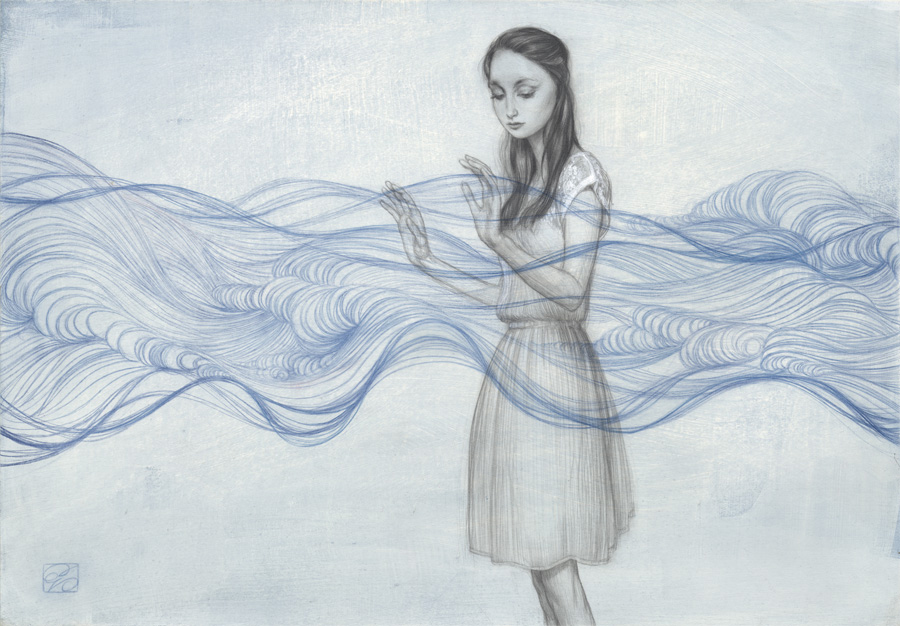
Mixed media on handmade paper, 12 x 18 in.
The New Art is figurative, narrative, and symbolic. But foremost it is sublimely real—the real that taps the rhythms of life as they traverse beneath the mutable surface of worldly appearances—and extend forwards and backwards in time. In a high-speed downloading world choking in the weeds of overproduction and overstimulation—I fear that the New Art (which by its nature defies fast and easy consumption) doesn’t stand half a chance of catching your eye, let alone winning your heart. But perhaps a short tale about why truth abides in the round that is art and life will do the trick.
Production of New Art first appeared about twenty years ago—among an impassioned, albeit hapless, coterie of young artists naïve enough to fall out of step with prevailing art tastes. These baby boom and millennial offspring, weaned on post-war contemporary tastes, missed out on the art that was fired by the true intent and spirit of modernism. What they saw was a swaggering art blinded by its own self-seeking arrogance and ceaseless call for attention—work that in the end was merely boring if not embarrassing, like a crass and ill-mannered dinner guest.
It got worse—irony (the inability to be genuine) prevailed and purged art of its foundational processes, historical lineage, and humanist intent. These art forms left little to engage a new generation of artists hoping to produce earnest works—an art that demonstrated some effort or imagined a good reason for being a mortal being living in a specific time and place—an existence that (according to contemporary art) was random and aimless. Hence what was left to make bore uneasy resemblance to clever product design—and the life of an artist meant producing sensational or seductive market objects trafficking temporal sensations (the more sensational the better) or overly confessional, self-indulgent gibberish (the more provocative the better). I would have bloody balked, too.
Born of disenchantment, the New Art seeks rather to enchant and looks to the beauty and mystery of life. It aims to mythologize human existence—even daring to suggest unity—as if we could all be one and the same. And how does the New Art stake such an outrageous, if not populist, claim? To begin, its works display artful technique and accessible imagery—individual studio productions slowly wrought by skilled and steadfast draughtsman, painters and sculptors that invite all that view their works to wonder at the flights to which human creation can ascend and aspire. In short, the New Art is very human—and yet it imagines an extraordinary presence. Creating New Art is one way, surely a noble and good way, to move towards that numinous unknowable.
If I still have your attention, I ask that you ponder this. Once upon a time, if only in an imagined golden past of my own wishful musing, learned men and women took great pleasure and pride in understanding what made art good and beautiful. They had mastered artistic literacy. They understood, too, that with this privileged knowledge came the responsibility of stewardship and patronage. They knew this to be true—that the salubrious benefit of visual art was not limited to sensorial pleasure; cultural expressions of the good and the beautiful are essential to the greater advancement of humankind—and visual art in particular could uniquely offer imagery that was essentially aspirational and selfless in its intent.
Here’s how you can explore this idea of cultural stewardship a bit further. There is an important show opening at the Portraits, Inc. gallery on Thursday, June 4th and running through July 18th. Titled “Blue Drawings,” it focuses on a foundational expression that is key to understanding the New Art. Out of all the art making techniques and media available to artists, hand drawing is the true gauge of an artist’s native talent and earnest study. It simply can’t be fudged—with minimal materials that evince every decision and every move of the artist’s eye and hand, either a drawing will demonstrate artistic genius—or it will not. And even a novice viewer will instinctually see the difference—the same arabesque rhythms that course through a beautiful drawing, course through your body. Those same rhythms course through cave walls graffitied by prehistoric shamans and later they soar high up into Michelangelo’s Sistine Chapel; later still they show up weaving in and out of Benton's public works murals and ultimately they crash through Pollock's drip paintings. It is all one and the same beat—life's libretto.
Lastly, I am certain that the "Blue Drawings" exhibition will change how you view art as well as your subsequent judgments as to what is good and beautiful in art—and by extension—in you and your fellows. I will venture that you will come to believe that the New Art is essential and deserving of your support. New Art artists and New Art patrons need each other—and the greater culture absolutely needs both.
To learn more about the "Blue Drawings" exhibition or any of the artists represented by Portraits, Inc., call 212.258.2233 or e-mail us.
Portraits, Inc. was founded in 1942 in New York on Park Avenue. Over its 70-year history, Portraits, Inc. has carefully assembled a select group of the world’s foremost portrait artists offering a range of styles and prices. Recognized as the industry leader, Portraits, Inc. provides expert guidance for discerning clients interested in commissioning fine art portraits.

